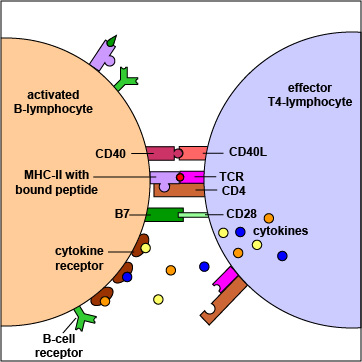
An effector T4-lymphocyte, such as a TFH cell, use its TCRs and CD4 molecules to bind to a complementary shaped MHC-II molecules with attached peptide epitope on an activated B-lymphocyte. This interaction, along with the binding of co-stimulatory molecules such as CD40 and B7 on the B-lymphocyte with their complementary ligands CD40L and CD28 on the effector T4-lymphocyte triggers the T4-lymphocyte to produce cytokines that enable the activated B-lymphocyte to proliferate, differentiate into antibody-secreting plasma cells, and switch classes of the antibodies being made.
Last updated: August, 2019
Please send comments and inquiries to Dr.
Gary Kaiser